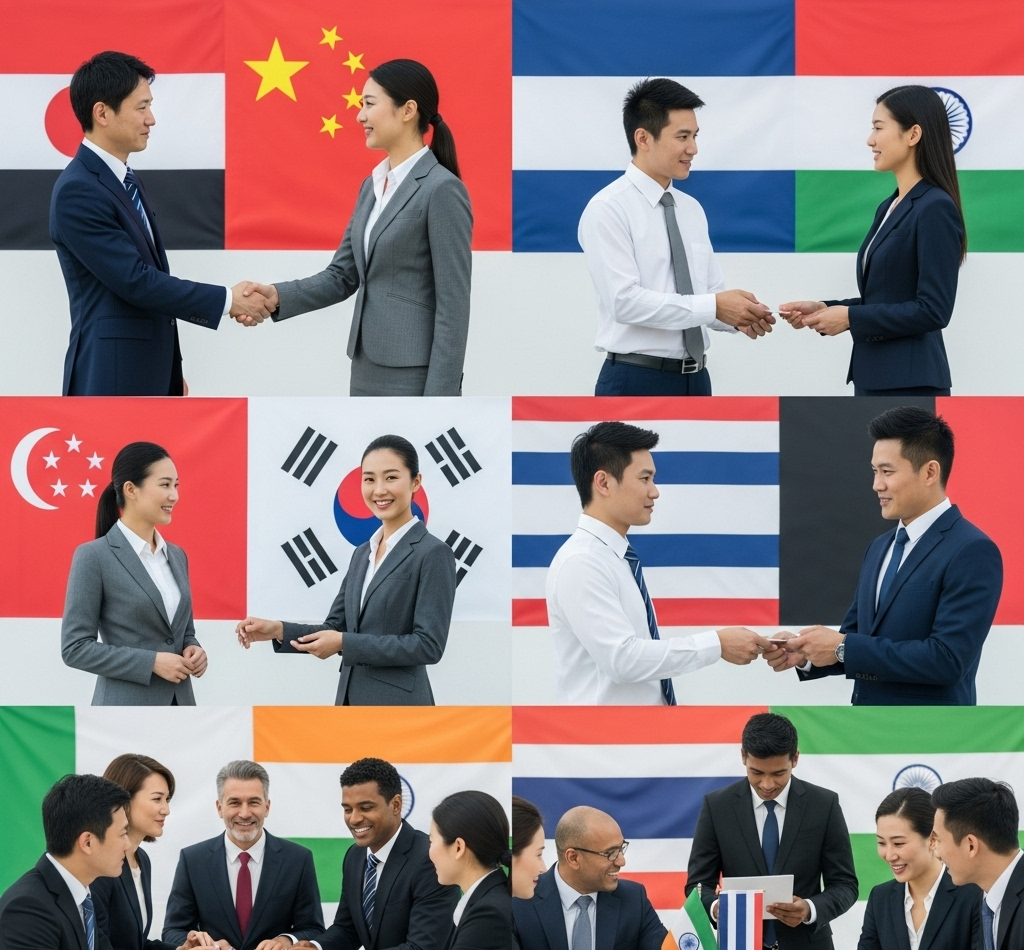— A Scene-by-Scene Guide to Smoother International Collaboration —
Introduction
As business across Asia becomes ever more globalized, understanding the unique manners and cultural expectations of each country is essential for building trust and successful partnerships. Even within Asia, there are remarkable differences in how people greet each other, conduct meetings, and build relationships. This article compares the business etiquette of Japan, China, South Korea, Singapore, India, and Thailand, breaking down the key points for each scene you may encounter.
1. Greetings, Business Cards, and First Impressions
Japan
- Bowing is the standard greeting.
- Business cards are exchanged with both hands, showing respect.
- People address each other by title and company name when first meeting.
China
- Greetings usually involve a light nod or a firm handshake.
- Business cards are given and received with both hands, and it’s polite to take a moment to review the card.
- Titles and company names are highly valued.
South Korea
- A handshake combined with a slight bow is common.
- Exchange business cards with both hands; age and position are respected.
- Hierarchical relationships and seniority are emphasized.
Singapore
- Handshakes are common, and business card exchanges are routine.
- Be mindful of the other person’s cultural background in this multicultural country.
- Confirm the correct way to address your counterpart for a good impression.
India
- Handshakes are common, but “Namaste” (palms together) is also used, depending on religion or gender.
- Offer business cards with the right hand or both hands.
- It’s important to be aware of religious and cultural sensitivities.
Thailand
- The “wai” (palms together and a slight bow) or a handshake is used for greetings.
- Give business cards with both hands, showing respect, especially to seniors.
- First impressions should be gentle and polite.

Need a quick break? Try Rocket Now! Get 5,000 Yen Coupon!
2. Meetings, Negotiations, and Decision-Making Styles
Japan
- Group consensus is prioritized, and decision-making is cautious.
- People speak modestly in meetings and respect hierarchy.
- Silence is valued as a sign of careful thought.
China
- Top-down decision-making is the norm.
- Subordinates speak less in meetings; senior leaders’ opinions are key.
- “Saving face” is important, so direct disagreement is avoided.
South Korea
- Hierarchy and seniority play a strong role; senior members lead meetings.
- Showing agreement and deference is important.
- Honest opinions may be shared privately after the meeting.
Singapore
- Meetings are efficient and fast-paced.
- Clear agendas and outcomes are prioritized.
- Sensitivity to different communication styles is appreciated in this multicultural setting.
India
- Top-down decisions are common.
- Meetings often include small talk and metaphors; conversations can stray from the main topic.
- Both direct and indirect communication are used, depending on the relationship.
Thailand
- Hierarchy is clear, and top management makes final decisions.
- Meetings are conducted gently, and direct refusals are avoided.
- Smiles and polite language are used to maintain harmony.
3. Dress Code and Appearance
Japan
- Conservative suits and ties are the norm.
- Cleanliness and subdued colors are preferred.
China
- In major cities, luxury brands and neat attire are favored.
- Clean appearance is important.
South Korea
- Trendy and branded business attire is common.
- Attention is paid to hair and makeup.
Singapore
- Business casual is on the rise, but suits are still safest for formal occasions.
- Lightweight fabrics are popular due to the climate.
India
- Suits are standard in cities, but casual attire is sometimes accepted in hot regions.
- Women may wear traditional outfits such as sarees or kurtas.
Thailand
- Fresh, neat clothing is valued; lightweight options are practical due to the heat.
- No tie or short sleeves are often acceptable.
4. Communication Styles
Japan
- Indirect expressions are common; people avoid saying “no” directly.
- “Reading the air” (tuning into unspoken feelings) is important.
China
- Indirect communication is used to protect face.
- Direct refusals or criticism are avoided.
South Korea
- Polite and respectful language, especially for seniors and superiors.
- Hierarchical awareness shapes communication.
Singapore
- English is the main language, but communication is respectful of cultural diversity.
- Direct yet polite exchanges are valued.
India
- Both straightforward and indirect expressions are used.
- Metaphors and humor are common in conversation.
Thailand
- Gentle tone and a smile are important.
- “No” is rarely said outright; refusals are expressed softly.
5. Business Meals and Social Etiquette
Japan
- Attention to seating order and toasting etiquette.
- Pouring drinks for others, especially seniors, is polite.
China
- Meals often involve large groups and round tables.
- Toasting rituals and sometimes offering cigarettes are part of the etiquette.
South Korea
- Strict rules for pouring drinks and drinking in front of seniors.
- Turn away from elders when drinking alcohol.
Singapore
- Be mindful of religious dietary restrictions.
- Vegetarian options and non-alcoholic choices are widely available.
India
- Use the right hand for eating and drinking.
- Alcohol is not always offered; respect those who abstain.
Thailand
- Wait for the most senior person to start eating.
- Don’t feel pressured to finish spicy food—just enjoy the experience.
Conclusion
Asian countries are incredibly diverse, each with its own unique mix of traditions, values, and business etiquette. Avoid assuming that “Japanese common sense” is universal, even within Asia. By learning about your counterpart’s customs and showing respect, you’ll lay the foundation for trust and successful collaboration.
Stay curious, flexible, and considerate—and you’ll flourish in any Asian business environment!





コメント